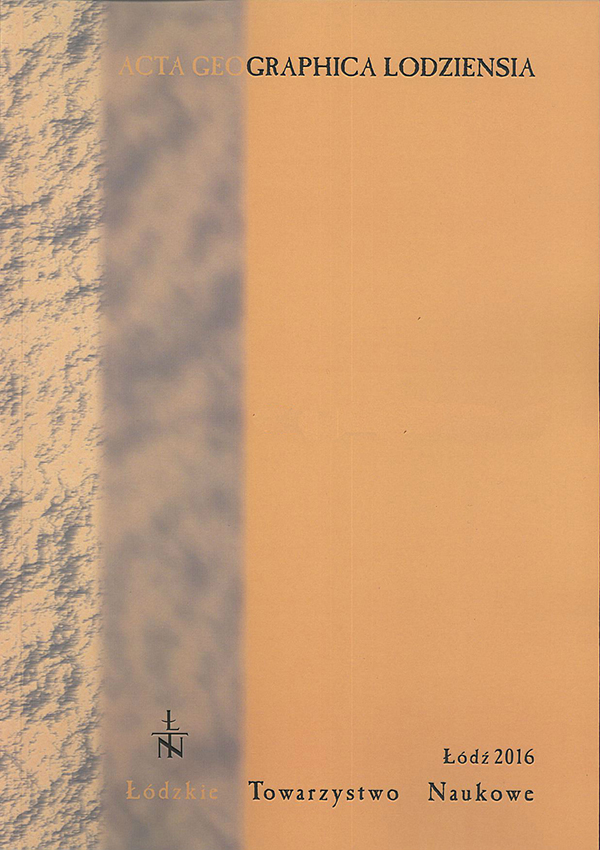Holoceńska historia roślinności siedlisk mokradłowych w dolinach rzecznych dorzecza górnej Odry
Holocene vegetation history of wetland habitats in the river valleys of the upper Odra River basin
Author(s): Krzysztof Wójcicki, Małgorzata NitaSubject(s): Geography, Regional studies, Environmental Geography
Published by: Łódzkie Towarzystwo Naukowe
Keywords: peatland; helophyte; pollen analysis; macrofossil analysis; alluvial plain; Racibórz Basin
Summary/Abstract: River valleys play an important role in the natural environment as areas characterized bya high level of biodiversity with reference to the diversity of habitats. The article presents the results ofthe research on the post-glacial evolution of vegetation within wetland habitats in the river valleys ofthe Racibórz Basin. The studied area is located in southern Poland, where wet land landscapes are notvery widespread. Little swamps, fens and wet meadows of fluvial or human origin dominate in thispart of the country. They are of crucial importance as enclaves for the development of the aquatic andwetland plant communities.Three sequences of deposits, representing small peatlands developed in the oxbow lakes, were thesubject of detailed studies. The material for palaeobotanical analyses was collected in three sites: Żywocice (50°27’11”N, 17°58’01”E) in the Osobłoga valley, Las Turbina (50°22’16”N, 18°17’48”E) inthe Kłodnica valley and Ruda Kozielska (50°12’32”N, 18°22’41”E) in the Ruda valley. A reconstructionof the local vegetation of the mires is based on the results of the macrofossil analysis. Pollen datawere used to reconstruct Holocene vegetation changes in the river valleys. The determination of theabsolute age of the deposits is based on 13 14C dates, measured by the radiocarbon laboratories in Kiev, Gliwice and Poznań.The study results indicate that the development of wetland habitats in the river valleys of theRacibórz Basin occurred under the influence of a similar set of factors: (1) geologic-geomorphological (origin of wetlands, developed within floodplain of sandy-bed meandering river), (2) hydrological (fedby soligenic waters in the distal and fluviogenic waters in the proximal zone of the valley bottom), and (3) anthropogenic (a similar history of catchment management). As a consequence, regularities in thedevelopment of the wetland vegetation are observed and the following stages of vegetation changescan be distinguished: 1. From the Late Vistulian to the Late Boreal – the development of Phragmitetea communities(which included Schoenoplectus lacustris, Phragmites australis, Equisetum and Cladium mariscusamong others), with the participation of aquatic plants (e.g. Myriophyllum spicatum, Myriophyllumverticillatum, Ceratophyllum, Nuphar lutea and Stratiotes aloides) in water bodies, whereas riparianforests with willows and poplars in moderately moist habitats. 2. The Atlantic and Sub-Boreal periods – the expansion of multi-species, climax forests with thedominance of Alnus glutinosa; in particular communities of Ribeso nigri-Alnetum in swamps (withFrangula alnus, Fraxinus excelsior, Salix, Rubus idaeus, Urtica dioica, Viola palustis and Climaciumdendroides among others). 3. The Sub-Atlantic period – the development of non-forest, sedge-moss communities due to humanimpact, initially from the alliance Magnocaricion (with Carex elata and Carex gracilis among others),evolving in acidophilic communities from the alliance Caricion nigrae on peatlands (with Carex canescens,Eriophorum angustifolium, Juncus articulatus and Drepanocladus exannulatus among others),whereas re-development of riparian forests on alluvial soils.In the methodological aspect, the research have confirmed the need for parallel application ofpollen and macrofossil analyses as complementary methods that allow to unravel some interpretationproblems related to the course of taphonomic processes in mires.
Journal: Acta Geographica Lodziensia
- Issue Year: 2016
- Issue No: 105
- Page Range: 93-105
- Page Count: 13
- Language: Polish

